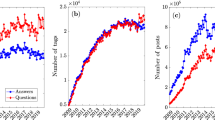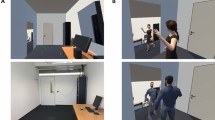Abstract
Conferences disseminate research, grow professional networks and train employees. Unfortunately, they also contribute to climate change and present barriers to achieving a socially sustainable work environment. Here, we analyse the recent impact of transforming in-person conferences into virtual conferences on improving diversity, equity and inclusion in science and engineering conferences. Factors including cost, gender, career stage and geographic location were evaluated. Virtual conferences demonstrated a clearly discernable and, in some cases, orders of magnitude improvement across nearly all metrics. On the basis of participant survey results, this improvement may be attributed to a combination of reduced financial and personal-life burdens. However, despite this clear impact, further development of virtual networking features and poster sessions is necessary to achieve widespread adoption and acceptance of this new format.
This is a preview of subscription content, access via your institution
Access options
Access Nature and 54 other Nature Portfolio journals
Get Nature+, our best-value online-access subscription
$32.99 / 30 days
cancel any time
Subscribe to this journal
Receive 12 digital issues and online access to articles
$119.00 per year
only $9.92 per issue
Buy this article
- Purchase on SpringerLink
- Instant access to full article PDF
Prices may be subject to local taxes which are calculated during checkout



Similar content being viewed by others
Data availability
The data that support the plots within this paper and other findings of this study have been deposited on Github28 (https://doi.org/10.5281/zenodo.5567764). Source data are provided with this paper.
Code availability
The custom code used to process and analyse the data for this study has been deposited on Github28 (https://doi.org/10.5281/zenodo.5567764).
References
Reshef, O. et al. How to organize an online conference. Nat. Rev. Mater. 5, 253–256 (2020).
Yakar, D. & Kwee, T. C. Carbon footprint of the RSNA annual meeting. Eur. J. Radiol. 125, 5 (2020).
Parker, M. & Weik, E. Free spirits? The academic on the aeroplane. Manag. Learn. 45, 167–181 (2014).
Klöwer, M., Hopkins, D., Allen, M. & Higham, J. An analysis of ways to decarbonize conference travel after COVID-19. Nature 583, 356–359 (2020).
Hewlett, S. A. et al. The Athena factor: reversing the brain drain in science, engineering, and technology. Harv. Bus. Rev. Res. Rep. 10094, 1–100 (2008).
Simard, C., Henderson, A., Gilmartin, S., Schiebinger, L. & Whitney, T. Climbing the Technical Ladder: Obstacles and Solutions for Mid-Level Women in Technology (Michelle R. Clayman Institute for Gender Research, 2008).
Urry, J. Social networks, mobile lives and social inequalities. J. Transp. Geogr. 21, 24–30 (2012).
Nature Index 2020 Annual Tables (Springer Nature, 2020); https://www.natureindex.com/annual-tables/2020
Cohen, S. A. & Gossling, S. A darker side of hypermobility. Environ. Plan. A 47, 1661–1679 (2015).
Rogelj, J. et al. in IPCC Special Report on Global Warming of 1.5 °C (eds Masson-Delmotte, V. et al.) Ch. 2 (WMO, 2018).
Fisher, M. J. & Marshall, A. P. Understanding descriptive statistics. Aust. Crit. Care 22, 93–97 (2009).
Schaab, G., Adams, S. & Coetzee, S. Conveying map finesse: thematic map making essentials for today’s university students. J. Geogr. High. Educ. https://doi.org/10.1080/03098265.2020.1850656 (2020)
Gender API (Gender-API.com, accessed 30 October 2020); https://gender-api.com
Accredited Postsecondary Minority Institutions (US Department of Education, accessed 30 October 2020); https://www2.ed.gov/about/offices/list/ocr/edlite-minorityinst-list-tab.html
The Carnegie Classification of Institutions of Higher Education (Indiana Univ. School of Education, accessed 30 October 2020); https://carnegieclassifications.iu.edu/lookup/srp.php?clq=%7B%22basic2005_ids%22%3A%2216%22%7D&start_page=standard.php&backurl=standard.php&limit=0,50
Facilitating Research at Primarily Undergraduate Institutions: Research in Undergraduate Institutions (RUI) and Research Opportunity Awards (ROA) (United States National Science Foundation, accessed 30 October 2020); https://www.nsf.gov/pubs/2014/nsf14579/nsf14579.htm
Doctorates Awarded, by State or Location, Broad Field of Study, and Sex of Doctorate Recipients: 2017 (United States National Science Foundation, 2018).
Doctorates Awarded, by State or Location, Broad Field of Study, and Sex of Doctorate Recipients: 2018 (United States National Science Foundation, 2019).
Google Maps v3 API (Google Inc., accessed 30 October 2020); https://developers.google.com/maps/documentation/geocoding/overview
The myclimate Flight Emission Calculator (Foundation myclimate, accessed 30 October 2020); https://www.myclimate.org/
Chong, H. G. & Ricaurte, E. E. Hotel Sustainability Benchmarking Tool 2015: Energy, Water, and Carbon (Cornell Hospitality Reports, Cornell Univ., 2015).
Dudas, G., Boros, L., Pal, V. & Pernyesz, P. Mapping cost distance using air traffic data. J. Maps 12, 695–700 (2016).
World Population Prospects 2019 (United Nations, 2019); https://population.un.org/wpp/Publications/
Greenhouse Gases Equivalencies Calculator - Calculations and References (United States Environmental Protection Agency, 2020); https://www.epa.gov/energy/greenhouse-gases-equivalencies-calculator-calculations-and-references
World Economic Outlook Database (International Monetary Fund, accessed 30 October 2020); https://www.imf.org/external/pubs/ft/weo/2017/02/weodata/index.aspx
Research and Development (UNESCO Institute for Statistics, 2020).
Employed Scientists and Engineers, by Occupation, Highest Degree Level, and Sex: 2017 (National Science Foundation, accessed 30 October 2020); https://ncses.nsf.gov/pubs/nsf19304/data
Skiles, M. Virtual-Conferences-Project (Zenodo, 2021); https://doi.org/10.5281/zenodo.5567764
Acknowledgements
We acknowledge G. Ragusa’s contribution to designing the pre- and postsurveys used for the POM 1 and 2 conferences. The work in this paper was supported by the NSF (award no. CBET 2029219 and CBET 1946392). We gratefully acknowledge access to data and consultation support provided by NAMS, ICLR, POM and IWA meeting leadership. K. Marvel’s input on AAS data and trends and his role in providing access to AAS meeting data is also acknowledged. This material is based on work supported by the NSF Graduate Research Fellowship Program under grant no. DGE-1610403. Any opinions, findings and conclusions or recommendations expressed in this material are those of the author(s) and do not necessarily reflect the views of the NSF.
Author information
Authors and Affiliations
Contributions
M.K., K.M.F. and M.S. conceived the idea. M.K., M.S., D.R.M. and D.C. collected data. M.S. and E.Y. analysed data. O.R., M.L.L, P.P.C, R.N., A.R. and A.A. provided access to data and provided insights on data. M.K., K.M.F., A.A. and M.S. wrote the manuscript.
Corresponding authors
Ethics declarations
Competing interests
M.K. and M.L.L. were organizers of NAMS. A.R. was an organizer of ICLR. P.P.C. and R.N. were organizers of IWA. A.A. and O.R. were organizers of POM. All other authors have no competing interests.
Additional information
Peer review information Nature Sustainability thanks Meagan Mauter and the other, anonymous, reviewer(s) for their contribution to the peer review of this work.
Publisher’s note Springer Nature remains neutral with regard to jurisdictional claims in published maps and institutional affiliations.
Supplementary information
Supplementary Information
Supplementary Discussion, Tables 1–21 and Figs. 1–15.
Source data
Source Data Fig. 1
Statistical source data.
Source Data Fig. 2
Statistical source data.
Source Data Fig. 3
Statistical source data.
Rights and permissions
About this article
Cite this article
Skiles, M., Yang, E., Reshef, O. et al. Conference demographics and footprint changed by virtual platforms. Nat Sustain 5, 149–156 (2022). https://doi.org/10.1038/s41893-021-00823-2
Received:
Accepted:
Published:
Issue date:
DOI: https://doi.org/10.1038/s41893-021-00823-2
This article is cited by
-
The main barriers to distributed interaction are not technological
Nature Astronomy (2025)
-
The impact of the virtualization of scholarly conferences on the gender structure of conference contributors
Scientometrics (2025)
-
Voices of conference attendees: how should future hybrid conferences be designed?
BMC Medical Education (2024)
-
Considerations for Planning Effective and Appealing Advisory Boards and Other Small-Group Meetings with Health Care Providers: Importance of Participant Preferences
Pharmaceutical Medicine (2024)
-
Decarbonizing research laboratories? The tensions associated with the commensurability of carbon and how it opens up the boundaries of responsibility attribution
Review of Agricultural, Food and Environmental Studies (2024)



